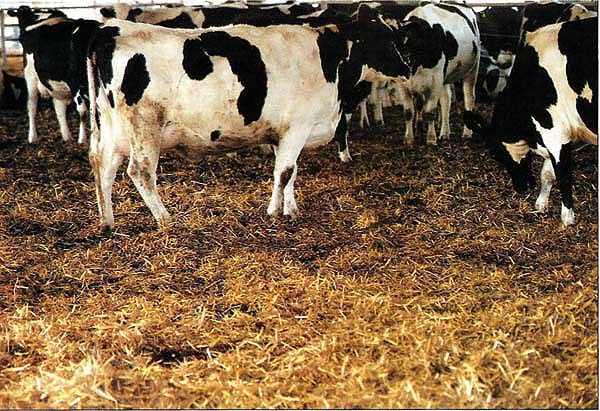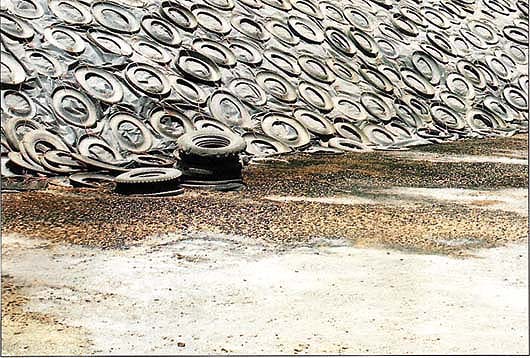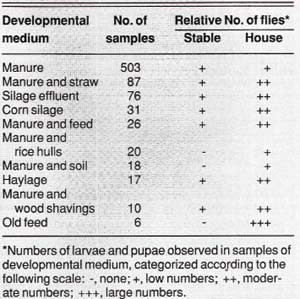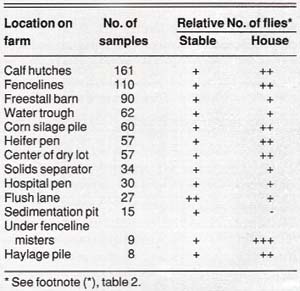All Issues
Stable fly and house fly breeding sites on dairies
Publication Information
California Agriculture 44(1):28-29.
Published January 01, 1990
PDF | Citation | Permissions
Abstract
Variations in management practices on dairies in central and southern California have resulted in some differences in fly breeding sites. Sanitation will have to be a focus of fly control efforts in the future on all dairies.
Full text
Manure mixed with straw, as in this hopital pen, was one of the major sources of fifth flies on the dairies sampled.
Dairy production, the most valuable agricultural enterprise in California, is worth almost $2 billion annually. California is second only to Wisconsin in dairy production and to Washington in production per cow. This high level of production is accomplished by confining cows to drylot (confinement management), which is undoubtedly the most efficient method of producing milk but results in rapid and concentrated accumulations of manure. These accumulations provide ideal breeding sites for various species of flies.
Most fly control efforts are directed at two important species: the stable fly, Stomoxys calcitrans (L.), and the house fly, Musca domestica L. The house fly is a warm-season pest (June to October), and becomes important to the dairy producer as a nuisance to cows and people residing close to the dairy. The stable fly, however, is primarily a spring pest (April to June), which inflicts economic loss by sucking blood from dairy cows. Little information is currently available, but moderate numbers of stable flies can apparently alter cow behavior, possibly affecting milk production.
California has approximately 1 million lactating cows, with the greatest concentrations in southern California (western Riverside and San Bernardino counties) and the San Joaquin Valley. The design and management of dairies can vary a great deal between central and southern California. For example, dairies in central California feed some form of silage and haylage along with alfalfa hay and may have freestall barns with solid-waste separators. In contrast, southern California dairies use only dry hay for roughage and do not need freestall barns.
Both central and southern California dairies use some type of drylot confinement and feed a wide variety of agricultural by-products. Given the importance of sanitation and manure management in controlling fly development on dairies, these different management styles can affect integrated fly control programs. We therefore surveyed dairies in central and southern California to identify breeding sites of both stable flies and house flies in each area and to provide dairy producers with information that would assist them in integrated control of flies.
Study methods
We chose four dairies at random from Riverside County in southern California and surveyed them for fly breeding each week between April 1987 and January 1988. The survey encompassed an entire seasonal cycle for both stable fly and house fly. We attempted to locate as many different sources of fly breeding as possible. Each breeding site found and the developmental media (such as manure and spilled feed) were recorded. Up to 100 immature stages of the fly species present were collected and taken to the laboratory for identification. We assumed that the collection adequately represented the immature fly population present in each breeding site.
In central California, we selected nine dairies at random in Tulare County. Similar surveys were conducted on each dairy once each month from April through November 1988. Fly larvae and pupae were identified to species. Density of each fly species was indexed according to the following subjective categories: absent, light, moderate, and heavy. As in southern California, the breeding site and composition of the breeding media were recorded.
Results
Eight types of breeding media were found on the four southern California dairies. The four types listed in table 1 contained nearly 99% (60,334) of the flies sampled. Over 88% (917) of the collections that supported fly breeding were manure sources uncontaminated by other substances such as hay, feed, or soil. An uncontaminated manure source was utilized more by house flies than stable flies. Stable flies were collected more frequently from manure sources containing straw or hay. These mixed substrates were found less frequently (approximately 7% of all samples collected) than manure alone but produced very high proportions of stable flies. Wet brewer's grain was another source of fly development, but consistently produced only house flies.
Overall, pure manure sources produced many more stable flies than did any other medium, despite the tremendous preference of house flies for these sites. These breeding sites were widespread over all the dairies. Two of the dairies surveyed each week practiced a method of manure management that involved mounding fresh manure in the center of the drylot. These manure mounds were consistent, season-long producers of house flies. Similarly aged manure under fencelines, adjacent to manger walls, and directly behind concrete feed aprons accounted for most of the breeding sites on the four southern California dairies.
Even covered corn silage piles provided egg-laying and larval development sites through holes in the plastic and uncovered areas. Effluent seeping from the piles was also a source of flies.
On the nine central California dairies, as on southern California dairies, uncontaminated, aged manure accounted for the vast majority of samples (table 2). Several different substrates associated with calf rearing and silage or haylage storage were encountered in central California. Calf hutches often had moist straw, rice hulls, and wood shavings. Overall, bedding material from plant sources in the calf hutch supported moderate levels of house fly and stable fly development.
TABLE 1. Immature stable flies and house flies collected from important developmental media encountered on surveys of southern California dairies
TABLE 3. Important locations of stable fly and house fly development encountered on surveys of central California dairies*
Significant house fly and stable fly numbers were observed on many occasions in both corn silage and haylage piles, as well as in the effluent that seeped from the piles. Both fly species were able to use corn silage and haylage as a developmental medium, even though most piles were covered with black plastic. Holes in the plastic and uncovered areas provided ample opportunity for egg-laying and larval development. Sizeable concentrations of larvae and pupae were found under the edges of the plastic cover at the sides of the slab silos.
Thirteen different breeding sites were identified on the central California dairies, compared with eight in southern California (table 3). The greater diversity of breeding sites may be related to the greater number of dairies sampled in central California versus southern California, but differing management systems influenced the greatest differences. For example, fly breeding in central California was found in corn silage piles, haylage piles, freestall barns, flush lanes, and manure from solids separators. Many dairies in central California have water mister lines above feed mangers to cool the cows during the summer. Leaking or dripping lines were responsible for a rather large and intense area of house fly breeding on one central California dairy (table 3), along fencelines where cow traffic was minimal. In contrast, mister lines are used less frequently on southern California dairies. Flush lanes in freestall barns tended to accumulate manure in areas where the force of the water did not effectively remove all the solids. This breeding source was encountered fairly frequently and supported development of both flies.
Calf-rearing operations are common in southern California, where large numbers of calves are reared until they are approximately 8 weeks old. These facilities have grown rapidly and now include approximately 75,000 calves in southern California alone. The increasing popularity of large operations has resulted in fewer calves being reared on individual dairies. Large calf-rearing operations exist in the San Joaquin Valley, but are not as centralized or intense as in southern California. This illustrates yet another important difference in fly breeding potential and fly management between the two locales, which influenced the greater number of breeding sites sampled in central versus southern California.
Conclusions
Our survey findings show that management practices generate both similar and different substrates for fly development on central and southern California dairies. Future fly control efforts on all California dairies will have to include a greater emphasis on sanitation, because of documented cases of insecticide resistance in fly populations and the likely loss of some existing fly control chemicals to the reregistration process. Recognition of the importance of management, and especially sanitation, in controlling fly development can only enhance the overall goal of fly control.









